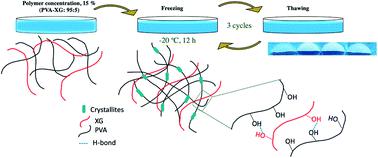Our official English website, www.x-mol.net, welcomes your feedback! (Note: you will need to create a separate account there.)
Cross-linked polyvinyl alcohol-xanthan gum hydrogel fabricated by freeze/thaw technique for potential application in soft tissue engineering
RSC Advances ( IF 3.9 ) Pub Date : 2022-08-05 , DOI: 10.1039/d2ra02295h Sergio Alberto Bernal-Chávez 1 , Sergio Alcalá-Alcalá 2 , Y S Tapia-Guerrero 3 , Jonathan J Magaña 3 , María Luisa Del Prado-Audelo 4 , Gerardo Leyva-Gómez 1
RSC Advances ( IF 3.9 ) Pub Date : 2022-08-05 , DOI: 10.1039/d2ra02295h Sergio Alberto Bernal-Chávez 1 , Sergio Alcalá-Alcalá 2 , Y S Tapia-Guerrero 3 , Jonathan J Magaña 3 , María Luisa Del Prado-Audelo 4 , Gerardo Leyva-Gómez 1
Affiliation

|
The search for materials and process parameters capable of generating hydrogels for soft tissue engineering applications, based on an experimental design strategy that allows the evaluation of several factors involved in their development and performance, has greatly increased. Nevertheless, the fabrication technique can influence their mechanical properties, swelling, crystallinity, and even their susceptibility to contamination by microorganisms, compromising their performance within the tissue or organ. This study aimed to evaluate the influence of the freeze/thaw technique on different characteristics of polyvinyl alcohol–xanthan gum hydrogel. Methods: this research analyzed the critical variables of the freeze/thaw process through a systematic study of a 2k factorial design of experiments, such as the proportion and concentration of polymers, freezing time and temperature, and freeze/thaw cycles. Additionally, physicochemical analysis, susceptibility to bacterial growth, and cell viability tests were included to approximate its cytotoxicity. The optimized hydrogel consisted of polyvinyl alcohol and xanthan gum at a 95 : 5 ratio, polymer mixture concentration of 15%, and 12 h of freezing with three cycles of freeze/thaw. The hydrogel was crystalline, flexible, and resistant, with tensile strengths ranging from 9 to 87 kPa. The hydrogel was appropriate for developing scaffolds for soft tissue engineering such as the cardiac and skeletal muscle, dermis, thyroid, bladder, and spleen. Also, the hydrogel did not expose an in vitro cytotoxic effect, rendering it a candidate for biomedical applications.
中文翻译:

冻融技术制备交联聚乙烯醇-黄原胶水凝胶在软组织工程中的潜在应用
基于允许评估涉及其开发和性能的几个因素的实验设计策略,对能够生成用于软组织工程应用的水凝胶的材料和工艺参数的搜索已大大增加。然而,制造技术会影响它们的机械性能、溶胀度、结晶度,甚至它们对微生物污染的敏感性,从而影响它们在组织或器官中的性能。本研究旨在评估冻融技术对聚乙烯醇-黄原胶水凝胶不同特性的影响。方法:本研究通过对 2 k实验的因子设计,例如聚合物的比例和浓度、冷冻时间和温度以及冷冻/解冻循环。此外,还包括物理化学分析、对细菌生长的敏感性和细胞活力测试,以估计其细胞毒性。优化后的水凝胶由聚乙烯醇和黄原胶组成,比例为 95:5,聚合物混合物浓度为 15%,冷冻 12 小时,冷冻/解冻三个循环。该水凝胶具有结晶性、柔韧性和抗性,拉伸强度范围为 9 至 87 kPa。该水凝胶适用于开发用于软组织工程的支架,例如心肌和骨骼肌、真皮、甲状腺、膀胱和脾脏。此外,水凝胶没有在体外暴露细胞毒性作用,使其成为生物医学应用的候选者。
更新日期:2022-08-05
中文翻译:

冻融技术制备交联聚乙烯醇-黄原胶水凝胶在软组织工程中的潜在应用
基于允许评估涉及其开发和性能的几个因素的实验设计策略,对能够生成用于软组织工程应用的水凝胶的材料和工艺参数的搜索已大大增加。然而,制造技术会影响它们的机械性能、溶胀度、结晶度,甚至它们对微生物污染的敏感性,从而影响它们在组织或器官中的性能。本研究旨在评估冻融技术对聚乙烯醇-黄原胶水凝胶不同特性的影响。方法:本研究通过对 2 k实验的因子设计,例如聚合物的比例和浓度、冷冻时间和温度以及冷冻/解冻循环。此外,还包括物理化学分析、对细菌生长的敏感性和细胞活力测试,以估计其细胞毒性。优化后的水凝胶由聚乙烯醇和黄原胶组成,比例为 95:5,聚合物混合物浓度为 15%,冷冻 12 小时,冷冻/解冻三个循环。该水凝胶具有结晶性、柔韧性和抗性,拉伸强度范围为 9 至 87 kPa。该水凝胶适用于开发用于软组织工程的支架,例如心肌和骨骼肌、真皮、甲状腺、膀胱和脾脏。此外,水凝胶没有在体外暴露细胞毒性作用,使其成为生物医学应用的候选者。



























 京公网安备 11010802027423号
京公网安备 11010802027423号